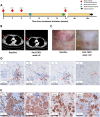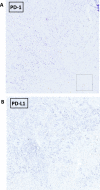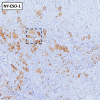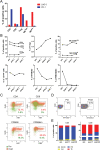Immunological characterization of a long-lasting response in a patient with metastatic triple-negative breast cancer treated with PD-1 and LAG-3 blockade
- PMID: 38336861
- PMCID: PMC10858221
- DOI: 10.1038/s41598-024-54041-9
Immunological characterization of a long-lasting response in a patient with metastatic triple-negative breast cancer treated with PD-1 and LAG-3 blockade
Abstract
In patients with advanced triple-negative breast cancer (TNBC), translational research efforts are needed to improve the clinical efficacy of immunotherapy with checkpoint inhibitors. Here, we report on the immunological characterization of an exceptional, long-lasting, tumor complete response in a patient with metastatic TNBC treated with dual PD-1 and LAG-3 blockade within the phase I/II study CLAG525X2101C (NCT02460224) The pre-treatment tumor biopsy revealed the presence of a CD3+ and CD8+ cell infiltrate, with few PD1+ cells, rare CD4+ cells, and an absence of both NK cells and LAG3 expression. Conversely, tumor cells exhibited positive staining for the three primary LAG-3 ligands (HLA-DR, FGL-1, and galectin-3), while being negative for PD-L1. In peripheral blood, baseline expression of LAG-3 and PD-1 was observed in circulating immune cells. Following treatment initiation, there was a rapid increase in proliferating granzyme-B+ NK and T cells, including CD4+ T cells, alongside a reduction in myeloid-derived suppressor cells. The role of LAG-3 expression on circulating NK cells, as well as the expression of LAG-3 ligands on tumor cells and the early modulation of circulating cytotoxic CD4+ T cells warrant further investigation as exploitable predictive biomarkers for dual PD-1 and LAG-3 blockade.Trial registration: NCT02460224. Registered 02/06/2015.
© 2024. The Author(s).
Conflict of interest statement
The authors declare no competing interests.
Figures




References
-
- Hong DS, et al. Phase I/II study of LAG525 ± spartalizumab (PDR001) in patients (pts) with advanced malignancies. J. Clin. Oncol. 2018;36(15_Suppl):3012. doi: 10.1200/JCO.2018.36.15_suppl.3012. - DOI
Publication types
MeSH terms
Substances
Associated data
LinkOut - more resources
Full Text Sources
Medical
Research Materials
Miscellaneous

